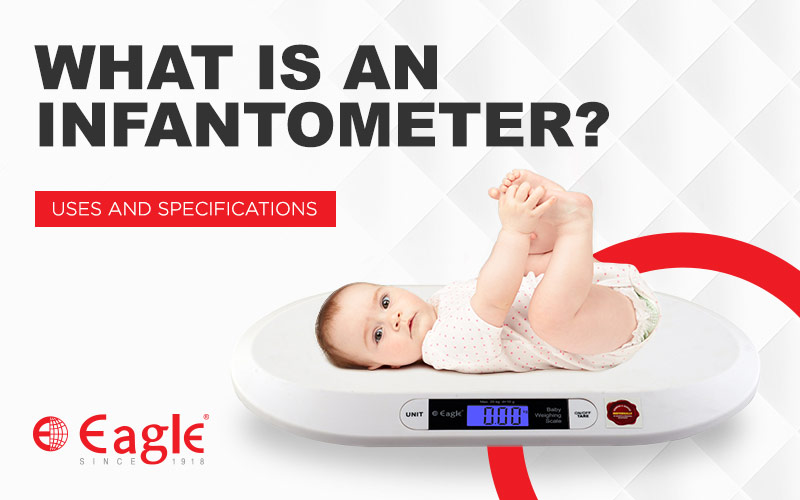The health and well-being of a newborn or a young baby are extremely important. No matter whether you are running a pediatric office, maternity ward, a pediatric healthcare establishment, or you are responsible for taking care of your baby at home, you need to arrange for the right tools to do this job well.
One such tool is an infantometer or a baby scale which is designed keeping the physique of infants in mind. These scales can precisely measure even the smallest increments in the length of a newborn.
This blog details all the basics of infantometers to help you understand what makes these essential for ensuring the health and consistent growth of babies so keep on reading till the end.
What is an Infantometer?
Infantometer Parts
Essential Specifications of an Infantometer
- High Accuracy
- Battery Operated
- Lightweight But Durable
- Large Digital Readout Display
Uses of an Infantometer
- Measuring Baby’s Length
- Monitoring of Pediatric Growth
- Nutritional Assessment
- Tracking Breastmilk Intake
- Clinical Research
What is an Infantometer?
It is a specialized length-measuring device that is used to measure the heights of infants with a high level of accuracy. Older infantometers were analog which consisted of a firm flat surface with a moveable headpiece and a fixed footpiece. They also include a measuring scale marked in inches or centimeters.
To measure the length, you simply place the baby on a flat surface and adjust the headpiece so that it touches the crown of the infant’s head. Then the footpiece is adjusted so that it touches the soles of the feet.
Recent infantometers use digital displays to give you a highly accurate and reliable reading of the length or height of a baby. These scales allow you to measure the height of infants in various units like centimeters, inches, etc.
Infantometers provide doctors and parents with reliable measurements that can help them ensure the safe and continued development of newborns.

Infantometer Parts
Here are some common infantometer parts that you see in most devices:
- Platform
The platform of an infantometer consists of a smooth and lightweight material that feels gentle on the body of the infant. The curved surface of these scales allows babies to feel snug while you measure the length.
- Head Piece
This movable component is used to keep the baby’s head in place while measuring the length.
- Foot Piece
This piece slides up or down the scale to touch the soles of the baby’s feet to give the right value of the length.
- Scale
It usually gives the value of a baby’s height or length in centimeters or inches.
- On/Off Button
As the name suggests, these buttons turn the infantometer ON or OFF. Some infantometers come with an auto-turn-off feature which turns the device off automatically when not in use.
Essential Specifications of an Infantometer
Following are the main infantometer specifications that you need to know:
- High Accuracy
Most infantometers are accurate to at least about 9” to 39”. These devices can record even the smallest increments in the length of a baby which gives you a clear picture of the growth and development of infants.
- Battery Operated
These tools come with rechargeable batteries which allows you to use them anywhere and at any time to ensure better tracking of the length of your baby.
- Lightweight But Durable
Infantometer scales are made from a robust material that can resist wear and tear for years to come. Moreover, the compact size of these scales makes them lightweight and portable.
- Large Digital Readout Display
Digital infantometers come with clear and large displays that allow you to record the length properly.

Uses of an Infantometer
Following are some common instances of infantometer use in home or clinic settings:
- Measuring Baby’s Length
An infantometer is used to measure the length of a baby right after its birth to continuously monitor their growth afterward. These scales come with digital displays and length measuring rods to record the length with a high level of accuracy.
- Monitoring of Pediatric Growth
Doctors can use these scales to keep track of a baby’s health and development over time. This allows them to uncover unusual elements that can affect a baby’s health in the long term.
- Nutritional Assessment
These scales can also provide valuable insights into the effectiveness of current nutrition and feeding regimens. This information helps doctors ensure the baby’s nutritional needs are met and the risks of deficiencies are eliminated.
- Clinical Research
Infantometers are also used in clinical trials and research to gather valuable insights into infant growth trends and patterns. This gives researchers a much better understanding of the pediatric development of babies.
Conclusion
The right infantometer can not only increase the accuracy of readings but it can also make the whole process easy for you and comfortable for the baby.
The information you get from these scales can help you better plan a baby’s healthcare, leading to consistent growth and fewer risks to his well-being. So, choose a quality infantometer to ensure you can track your baby’s growth and provide them with quality care every day. Visit Eagle Scales today to order our top-quality baby weighing scale for clinical or home use.





